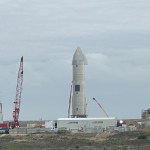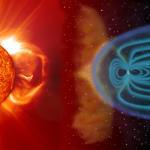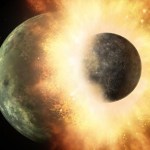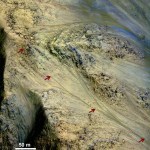Dominique Luchart's Blog, page 664
March 31, 2021
Interviews with 15 people show CISA is underfunded, short on talent, outmatched by adversaries, and overwhelmed by the fallout from two massive cyberattacks (Eric Geller/Politico)
The post Interviews with 15 people show CISA is underfunded, short on talent, outmatched by adversaries, and overwhelmed by the fallout from two massive cyberattacks (Eric Geller/Politico) appeared first on NEWDAWN Blog.
Huawei offsets US sanctions with dominance in China,
Huawei has released its annual report and financial information for 2020, demonstrating the effect that US sanctions had on its business last year. The report shows that while revenue from North America and Europe has fallen significantly, stronger performance in China has allowed the company to record higher sales and net profit than a year ago.
Huawei doesn’t report traditional quarterly earnings, since it’s a private company with an unusual employee ownership structure. Its annual reports tend to be the best look at how it’s actually performing.
The company’s revenue for 2020 was 891.4 billion yuan (~$136 billion), a 3.8-percent increase on 2019. Net profit was up 3.2 percent to 64.6 billion yuan (~$9.86 billion). 66 percent of Huawei’s sales were in China last year, up from 59 percent the previous year; revenue from the Americas, meanwhile, plunged 24.5 percent.
Huawei notes that its carrier business grew in China because of a fast local 5G rollout, which leans heavily on Huawei’s technology — competitor Nokia is notable by its absence in the market. 5G network deployment was also strong in Europe, the Middle East, and Africa, according to the company. But in the Americas, the sharp decline in revenue was attributed to “investment fluctuations in some countries’ telecoms markets.” Countries like Canada chose Samsung over Huawei for their 5G rollout, for example.
An unnamed Huawei executive told The Washington Post and other publications this week that 2020 was “a really tough year” for the company. The export restrictions imposed by the US are said to have had “a huge impact to Huawei, especially for Huawei’s consumer business.”
According to Huawei, its consumer division actually grew its revenue by 3.3 percent in 2020. It’s clear, though, that the company’s smartphone sales in particular are falling even in China, largely due to a lack of manufacturing capability as Huawei relies on components it stockpiled before the sanctions took hold. And as Bloomberg notes, 2020’s final quarter saw Huawei’s quarterly profits shrink year on year for the first time ever.
“For the long run we believe this is damaging the reputation and also the competitive advantage of US industry,” the executive reportedly said, adding that Huawei is yet to see any sign that the Biden administration might relax the restrictions that were put in place under former President Trump.
The post Huawei offsets US sanctions with dominance in China, appeared first on NEWDAWN Blog.
Huawei offsets US sanctions with dominance in China, Sam Byford
 Illustration by Alex Castro / The Verge
Illustration by Alex Castro / The VergeHuawei has released its annual report and financial information for 2020, demonstrating the effect that US sanctions had on its business last year. The report shows that while revenue from North America and Europe has fallen significantly, stronger performance in China has allowed the company to record higher sales and net profit than a year ago.
Huawei doesn’t report traditional quarterly earnings, since it’s a private company with an unusual employee ownership structure. Its annual reports tend to be the best look at how it’s actually performing.
The company’s revenue for 2020 was 891.4 billion yuan (~$136 billion), a 3.8-percent increase on 2019. Net profit was up 3.2 percent to 64.6 billion yuan (~$9.86 billion). 66 percent of…
The post Huawei offsets US sanctions with dominance in China, Sam Byford appeared first on NEWDAWN Blog.
BrightInsight, which helps drug/device makers build apps for patients and doctors, raises $101M Series C led by General Catalyst, source says at $750M valuation (John Tozzi/Bloomberg)
The post BrightInsight, which helps drug/device makers build apps for patients and doctors, raises $101M Series C led by General Catalyst, source says at $750M valuation (John Tozzi/Bloomberg) appeared first on NEWDAWN Blog.
Facebook is making it easier to turn off algorithmic ranking in your News Feed,
Facebook is introducing a handful of new features that will give users greater control over their News Feed, including an easier way to turn off the feed’s algorithmic ranking and display content in the order it was posted instead.
The changes build on previous tweaks to News Feed functionality. Last October, Facebook introduced a “Favorites” tool that allows users to select up to thirty friends and pages, prioritizing their content or displaying it in a separate feed. The company also offers users the option to sort their feeds by “most recent,” but buries these options in obscure menus.
Facebook is now making these “Favorites” and “Recent” filters much more prominent, putting them right at the top of the News Feed as separate tabs that users can switch between. You can see what that looks like in the screenshots below:
 The News Feed filter bar will let users swap between algorithmic, chronological, and “favorites” filters. Image: Facebook
The News Feed filter bar will let users swap between algorithmic, chronological, and “favorites” filters. Image: FacebookThis filter bar is launching globally on Facebook’s Android app today and coming to iOS “in the coming weeks.” It’s not clear if it will be available on the web version of Facebook.
But there’s a big caveat: the filter bar isn’t a permanent addition to Facebook’s user interface. The company told The Verge that the feature will disappear if users don’t access the Favorites tool for seven days. They will then have to find their favorites through the preferences menu for the News Feed and the filter bar will return. Similarly, the “most recent” tab will also disappear if not regularly accessed.
In addition to the filter bar, Facebook is introducing a new tool that lets users limit who can comment on their posts (this can be restricted to friends or just to tagged people and pages) and expanding the content covered by its “Why am I seeing this?” feature.
This latter tool was introduced last April and lets users click on posts suggested by Facebook’s algorithms to see why it was recommended to them. These explanations will now cover suggested posts from pages or people that users don’t follow, showing how posts’ related topics, interactions, and location led to them being suggested.
 “Why am I seeing this?” will offer more information about why posts were suggested to users. Image: Facebook
“Why am I seeing this?” will offer more information about why posts were suggested to users. Image: FacebookThese changes are relatively minor, but overall give people more control over Facebook’s often opaque algorithms. The changes suggest that the world’s largest social network is keen to deflect criticism over choices made by its algorithmic systems. This is not surprising considering that the company has repeatedly come under fire over studies that show these automated systems amplify misinformation and extremist content in an apparent bid to drive up user engagement — a metric that rules Facebook’s design choices.
Such criticisms have been levied against the site for years, but have become increasingly sharp in recent months as legislators and the company’s own Oversight Board mull more intrusive regulation of Facebook’s algorithms. With this in mind, it’s makes sense for the company to give its users the ability to opt-out of algorithmic sorting altogether.
But as is often the case with Facebook, the company seems hesitant to commit to changes that might undermine its own engagement stats. If the filter bar disappears after seven days of inactivity, it invites an obvious question: is Facebook really serious about letting users choose what they see on the site, or does it just want to give the appearance of control?
The post Facebook is making it easier to turn off algorithmic ranking in your News Feed, appeared first on NEWDAWN Blog.
Facebook is making it easier to turn off algorithmic ranking in your News Feed, James Vincent
 Image: Facebook
Image: FacebookFacebook is introducing a handful of new features that will give users greater control over their News Feed, including an easier way to turn off the feed’s algorithmic ranking and display content in the order it was posted instead.
The changes build on previous tweaks to News Feed functionality. Last October, Facebook introduced a “Favorites” tool that allows users to select up to thirty friends and pages, prioritizing their content or displaying it in a separate feed. The company also offers users the option to sort their feeds by “most recent,” but buries these options in obscure menus.
Facebook is now making these “Favorites” and “Recent” filters much more prominent, putting them right at the top of the News Feed as separate tabs…
The post Facebook is making it easier to turn off algorithmic ranking in your News Feed, James Vincent appeared first on NEWDAWN Blog.
March 30, 2021
SpaceX may attempt to launch its Starship SN11 rocket launch today, ,

SpaceX is aiming to launch its newest Starship rocket prototype today (March 30) and you’ll be able to watch it live when it flies.
The Starship SN11 rocket was initially expected to attempt a launch from SpaceX’s Starbase test site near Boca Chica Village in South Texas on Monday, but an inspector with the Federal Aviation Administration (FAA), which oversees commercial space launches, was unable to reach the launch site in time, SpaceX CEO Elon Musk said.
“FAA inspector unable to reach Starbase in time for launch today,” Musk wrote in an update on Twitter. “Postponed to no earlier than tomorrow.”
Today’s launch window runs from 8 a.m. EDT to 3 p.m. EDT (1200-1900 GMT), according to officials with Cameron County, which has set up road closures for today’s launch attempt. A backup date is available on April 2.
If SpaceX is able to launch its Starship SN11 on Tuesday, the rocket is expected to reach an altitude of 6.2 miles (10 kilometers) and then attempt a landing. You’ll be able to watch here and on Space.com’s homepage, as well as watch directly from SpaceX here and on YouTube. SpaceX’s webcast usually begins about 5 minutes before a Starship launch attempt.
Video: Watch SpaceX test-fire the Starship SN11 rocket prototype
Join our launch chat!
Join the Space.com forums here to discuss SpaceX and space travel. Let the community know what you’re thinking!
Tuesday’s potential Starship SN11 launch follows an earlier attempt on Friday (March 26), when SpaceX test-fired the rocket’s three Raptor engines but opted not to attempt a launch in order to allow time for extra checks on the vehicle.
“Doing our best to land & fully recover,” Musk said at the time.
Starship SN11 is the latest test vehicle for a planned fully reusable launch system SpaceX is developing for deep-space flights to the moon and Mars. The company has launched three vehicles so far: SN8, SN9 and SN10. The SN8 and SN9 Starship tests ended with failed landing attempts, with the vehicles crashing and exploding.
The Starship SN10 prototype flew on March 3 and stuck its landing, but exploded shortly after touchdown. SpaceX is hoping for a clear success with the Starship SN11 test flight.
“The Starship prototype will descend under active aerodynamic control, accomplished by independent movement of two forward and two aft flaps on the vehicle,” SpaceX wrote in a mission overview. “All four flaps are actuated by an onboard flight computer to control Starship’s attitude during flight and enable precise landing at the intended location.”
SpaceX plans to launch the 165-foot-tall (50 meters) Starship spacecraft into orbit using a massive heavy-lift booster called Super Heavy, which is also under development. Musk showed off the first Super Heavy test article earlier this month to be used for structural checks.
SpaceX has already booked one Starship flight around the moon for Japanese billionaire Yusaku Maezawa and eight other people. Maezawa’s “dearMoon” mission is targeted to launch in 2023. SpaceX is also relying on Starship as one of three teams vying to build a crewed landing vehicle to deliver NASA astronauts to the moon under the agency’s Artemis program.
Editor’s note: This story was updated at 1:51 p.m. EDT to include SpaceX’s launch delay for Starship SN11 and plans for a Tuesday launch attempt.
Email Tariq Malik at tmalik@space.com or follow him @tariqjmalik. Follow us @Spacedotcom, Facebook and Instagram.
Join our Space Forums to keep talking space on the latest missions, night sky and more! And if you have a news tip, correction or comment, let us know at: community@space.com.
The post SpaceX may attempt to launch its Starship SN11 rocket launch today, , appeared first on NEWDAWN Blog.
Climate explained: How particles ejected from the sun affect Earth’s climate, ,

This article was originally published at The Conversation. The publication contributed the article to Space.com’s Expert Voices: Op-Ed & Insights .
Annika Seppala, Senior Lecturer in Geophysics, University of Otago
Climate Explained is a collaboration between The Conversation, Stuff and the New Zealand Science Media Centre to answer your questions about climate change.
If you have a question you’d like an expert to answer, please send it to climate.change@stuff.co.nz
When the Sun ejects solar particles into space, how does this affect the Earth and climate? Are clouds affected by these particles?
When we consider the sun’s influence on Earth and our climate, we tend to think about solar radiation. We are acutely aware of the skin-burning dangers of ultraviolet, or UV, radiation.
But the sun is an active star. It also continuously releases what is known as “solar wind,” made up of charged particles, largely protons and electrons, that travel at speeds of hundreds of kilometres per hour.
Some of these particles that reach Earth are guided into the polar atmosphere by our magnetic field. As a result, we can see the southern lights, aurora australis, in the southern hemisphere, and the northern equivalent, aurora borealis.
[image error]
The southern lights, less-photographed than their northern counterparts, are seen from the air in a recent charter flight from New Zealand. (Image credit: Stephen Voss/YouTube)This visible manifestation of solar particles entering Earth’s atmosphere is a constant reminder there is more to the sun than sunlight. But the particles have other effects as well.
Read more: Why is the sun’s atmosphere so hot? Spacecraft starts to unravel our star’s mysteries
Solar particles and ozoneWhen solar particles enter the atmosphere, their high energies ionise neutral atmospheric nitrogen and oxygen molecules, which make up 99% of the atmosphere. This “energetic particle precipitation,” named because it’s like a rain of particles from space, is a major source of ionisation in the polar atmosphere above 30 km altitude — and it sets off a chain of reactions that produces chemicals that facilitate the destruction of ozone.
The impact of solar particles on atmospheric ozone was first observed in 1969. Since the early 2000s, thanks to new kinds of satellite observations, we have seen growing evidence that solar particles play an important part in influencing polar ozone. During particularly active times, when the Sun releases large amounts of particles into space, up to 60% of ozone at altitudes above 50 km can be depleted. The effect can last for weeks.
Lower down in the atmosphere, below 50 km, solar particles are important contributors to the year-to-year variability in polar ozone levels, often through indirect pathways. Here, solar particles again contribute to ozone loss, but a recent discovery showed they also help curb some of the depletion in the Antarctic ozone hole.
How ozone affects the climateMost of the ozone in the atmosphere resides in a thin layer at altitudes of 20-25 km — the “ozone layer.”
But ozone is everywhere in the atmosphere, from the Earth’s surface to altitudes above 100 km. It is a greenhouse gas and plays a key role in heating and cooling the atmosphere, which makes it critical for climate.
In the Southern Hemisphere, changes in polar ozone are known to influence regional climate conditions.
[image error]
Solar particles ionise nitrogen and oxygen molecules in the atmosphere, which leads to other chemical reactions that contribute to ozone destruction. (Image credit: NASA)Its depletion above Antarctica had a cooling effect, which in turn pulled the westerly wind jet that circles the continent closer. As the Antarctic hole recovers, this wind belt can meander further north and affect rainfall patterns, sea-surface temperatures and ocean currents. The Southern Annular Mode describes this north-south movement of the wind belt that circles the southern polar region.
Ozone is important for future climate predictions, not only in the thin ozone layer, but throughout the atmosphere. It is crucial we understand the factors that influence ozone variability, be it man-made or natural like the sun.
The sun’s direct influenceThe link between solar particles and ozone is reasonably well established, but what about any direct effects solar particles may have on the climate?
We have observational evidence that solar activity influences regional climate variability at both poles. Climate models also suggest such polar effects link to larger climate patterns (such as the Northern and Southern Annular Modes) and influence conditions in mid-latitudes.
The details are not yet well understood, but for the first time the influence of solar particles on the climate system will be included in climate simulations used for the upcoming Intergovernmental Panel on Climate Change (IPCC) assessment.
Read more: Solar weather has real, material effects on Earth
Through solar radiation and particles, the Sun provides a key energy input to our climate system. While these do vary with the Sun’s 11-year cycle of magnetic activity, they can not explain the recent rapid increase in global temperatures due to climate change.
We know rising levels of greenhouse gases in the atmosphere are pushing up Earth’s surface temperature (the physics have been known since the 1800s). We also know human activities have greatly increased greenhouse gases in the atmosphere. Together these two factors explain the observed rise in global temperatures.
Clouds are much lower in the atmosphere than where most solar particles penetrate. Particles know as galactic cosmic rays (coming from the centre of our galaxy rather than the sun) may be linked to cloud formation.
It has been suggested cosmic rays could influence the formation of condensation nuclei, which act as “seeds” for clouds. But recent research at the CERN nuclear research facility suggests the effects are insignificant.
This doesn’t rule out some other mechanisms for cosmic rays to affect cloud formation, but thus far there is little supporting evidence.
This article is republished from The Conversation under a Creative Commons license. Read the original article.
Follow all of the Expert Voices issues and debates — and become part of the discussion — on Facebook and Twitter. The views expressed are those of the author and do not necessarily reflect the views of the publisher.
The post Climate explained: How particles ejected from the sun affect Earth’s climate, , appeared first on NEWDAWN Blog.
A remnant of a protoplanet may be hiding inside Earth, ,

A protoplanet slammed into the Earth about 4.5 billion years ago, knocking loose a chunk of rock that would later become the moon. Now, scientists say that remnants of that protoplanet can still be found, lodged deep inside Earth, Science Magazine reported.
If remains of the protoplanet, known as Theia, did stick around after the impact, that may explain why two continent-size blobs of hot rock now lie in the Earth‘s mantle, one beneath Africa and the other under the Pacific Ocean. These massive blobs would stand about 100 times taller than Mount Everest, were they ever hauled up to Earth’s surface, Live Science previously reported.
Theia’s impact both formed the moon and transformed Earth’s surface into a roiling magma ocean, and some scientists theorize that the blobs formed as that ocean cooled and crystalized, Science reported. Others think the blobs contain Earth rocks that somehow escaped the effects of the collision and nestled, undisturbed for millions of years, near the planet’s center.
But last week, at the Lunar and Planetary Science Conference, Qian Yuan, a doctoral student in geodynamics at Arizona State University (ASU) Tempe, presented an alternate hypothesis.
Related: Earth has a hidden layer, and no one knows exactly what it is
He proposed that, after the moon-forming impact, dense material from Theia’s mantle descended deep beneath the Earth’s surface, accumulating into what we now know as “the blobs.” According to Yuan’s models, rocks 1.5% to 3.5% denser than Earth’s mantle would not mix into the surrounding rock. Rather, they would sink to the bottom of the mantle, near the inner core.
“This crazy idea is at least possible,” Yuan told Science.
A 2019 study, published in the journal Geochemistry, supports the idea that Theia’s mantle was denser than Earth’s — about 2% to 3.5% denser, Science reported. The study authors drew conclusions about Theia’s size and chemical composition based on an analysis of Apollo moon rocks, which contained a far higher ratio of light hydrogen to heavy hydrogen than Earth rocks, they found. (Light and heavy hydrogen differ by the number of neutrons in each atom’s nucleus.)
To supply the moon with so much light hydrogen, Theia must have been very large, nearly the size of Earth at the time of impact, and very dry, since water formed in interstellar space would contain a heavy form of hydrogen called deuterium, which Theia lacked, the authors concluded. Meanwhile, the interior of the hulking protoplanet would have held a dense, iron-rich mantle, Science reported.
Related Content
—15 incredible places on Earth that are frozen in time
—Photos: Artistic views of Earth from above
—Too hot to handle: 7 sizzling places on Planet Earth
Per Yuan’s theory, while the lighter rocks hurtled into space to form the moon, chunks of the iron-rich mantle would have barreled down toward the Earth’s core in the wake of Theia’s impact, where they settled and formed the enigmatic blobs. “I think [the idea is] completely viable until someone tells me it’s not,” Edward Garnero, a seismologist at ASU Tempe who was not involved in the work, told Science.
However, not everyone’s convinced. You can read more about competing theories of how the blobs formed at Science Magazine.
Originally published on Live Science.
A protoplanet slammed into the Earth about 4.5 billion years ago, knocking loose a chunk of rock that would later become the moon. Now, scientists say that remnants of that protoplanet can still be found, lodged deep inside Earth, Science Magazine reported.
If remains of the protoplanet, known as Theia, did stick around after the impact, that may explain why two continent-size blobs of hot rock now lie in the Earth‘s mantle, one beneath Africa and the other under the Pacific Ocean. These massive blobs would stand about 100 times taller than Mount Everest, were they ever hauled up to Earth’s surface, Live Science previously reported.
Theia’s impact both formed the moon and transformed Earth’s surface into a roiling magma ocean, and some scientists theorize that the blobs formed as that ocean cooled and crystalized, Science reported. Others think the blobs contain Earth rocks that somehow escaped the effects of the collision and nestled, undisturbed for millions of years, near the planet’s center.
But last week, at the Lunar and Planetary Science Conference, Qian Yuan, a doctoral student in geodynamics at Arizona State University (ASU) Tempe, presented an alternate hypothesis.
Related: Earth has a hidden layer, and no one knows exactly what it is
He proposed that, after the moon-forming impact, dense material from Theia’s mantle descended deep beneath the Earth’s surface, accumulating into what we now know as “the blobs.” According to Yuan’s models, rocks 1.5% to 3.5% denser than Earth’s mantle would not mix into the surrounding rock. Rather, they would sink to the bottom of the mantle, near the inner core.
“This crazy idea is at least possible,” Yuan told Science.
A 2019 study, published in the journal Geochemistry, supports the idea that Theia’s mantle was denser than Earth’s — about 2% to 3.5% denser, Science reported. The study authors drew conclusions about Theia’s size and chemical composition based on an analysis of Apollo moon rocks, which contained a far higher ratio of light hydrogen to heavy hydrogen than Earth rocks, they found. (Light and heavy hydrogen differ by the number of neutrons in each atom’s nucleus.)
To supply the moon with so much light hydrogen, Theia must have been very large, nearly the size of Earth at the time of impact, and very dry, since water formed in interstellar space would contain a heavy form of hydrogen called deuterium, which Theia lacked, the authors concluded. Meanwhile, the interior of the hulking protoplanet would have held a dense, iron-rich mantle, Science reported.
Related Content
—15 incredible places on Earth that are frozen in time
—Photos: Artistic views of Earth from above
—Too hot to handle: 7 sizzling places on Planet Earth
Per Yuan’s theory, while the lighter rocks hurtled into space to form the moon, chunks of the iron-rich mantle would have barreled down toward the Earth’s core in the wake of Theia’s impact, where they settled and formed the enigmatic blobs. “I think [the idea is] completely viable until someone tells me it’s not,” Edward Garnero, a seismologist at ASU Tempe who was not involved in the work, told Science.
However, not everyone’s convinced. You can read more about competing theories of how the blobs formed at Science Magazine.
Originally published on Live Science.
The post A remnant of a protoplanet may be hiding inside Earth, , appeared first on NEWDAWN Blog.
Mars’ dark streaks are probably caused by dry landslides, ,

Mars’ bizarre dark streaks may not be so astrobiologically intriguing after all.
Those streaks, known as recurring slope lineae, were discovered in 2011 by scientists studying imagery captured by the powerful High Resolution Imaging Experiment (HiRISE) camera aboard NASA’s Mars Reconnaissance Orbiter (MRO).
As their name suggests, recurring slope lineae, or RSL for short, are found on Red Planet slopes. The marks creep down steep inclines, especially in Mars’ southern hemisphere, during warm times of the year and fade away as the weather cools.
Photos: The search for water on Mars
These characteristics led scientists to speculate that the dark marks could be caused by salty liquid water flowing or seeping through the red dirt, in spots that get warm enough for some of Mars’ plentiful subsurface ice to melt. That exciting hypothesis got a boost in 2015, when data gathered by MRO’s Compact Reconnaissance Imaging Spectrometer instrument, or CRISM, revealed the apparent signature of hydrated salts at some RSL locales. That’s just what you’d expect to see after briny liquid had evaporated away.
But the liquid-water explanation has been losing favor over the last few years. For example, a 2018 study cast serious doubt on the CRISM find, suggesting that the supposed hydrated-salt fingerprint was actually an artifact of data processing. And researchers have been finding more and more evidence, from both experimental and modeling work, that dry landslides are etching the dark marks into warm Martian slopes.
Another such study came out this past January. HiRISE imagery revealed a big increase in RSL activity in the wake of the global dust storm that killed NASA’s Opportunity Mars rover in 2018, researchers report in the paper, which was published in Journal of Geophysical Research: Planets.
The team, led by HiRISE principal investigator Alfred McEwen, counted 150 active RSL sites during the year of the dust storm, compared to an annual average of just 36 in the six previous years. (The years here are Mars years, each of which lasts about 687 Earth days.)
“There are clear dust devil tracks in 73% of post-storm images in the southern middle latitudes in the summer, where and when dust devils are most active,” the researchers wrote in the study.
“The tracks indicate dust lifting, by several mechanisms,” they added. “We suggest that dust lifting processes on steep slopes may initiate and sustain RSL formed from flows of dust (perhaps clumped) and/or sand that is destabilized by dust movement.”
McEwen discussed the recent study last Thursday (March 25) during a presentation at the 2021 Spring Meeting of the U.S. National Academies of Sciences, Engineering and Medicine’s Committee on Planetary Protection. (Planetary protection refers to efforts to avoid contaminating other worlds with microbes from Earth, and to prevent potential alien bugs from getting a foothold on our planet.)
He also gave an overview of the decade-long history of RSL research, which he said now points strongly toward dry explanations for the dark features.
“None of the wet hypotheses have survived, in my opinion,” said McEwen, who’s based at the University of Arizona’s Lunar and Planetary Laboratory.
He also said he doesn’t believe that RSL sites should be regarded as “special regions” — locales that might be capable of supporting Earth life and are therefore off-limits to exploration by all but the most rigorously sterilized spacecraft.
If that view becomes the consensus, it will be easier for NASA and other space agencies to send rovers to RSL sites and study the mysterious features up close. But consensus has not yet been reached; the new study, while suggestive, doesn’t slam the door on the wet-RSL hypothesis.
“These debates will continue,” McEwen said.
Mike Wall is the author of “ Out There ” (Grand Central Publishing, 2018; illustrated by Karl Tate), a book about the search for alien life. Follow him on Twitter @michaeldwall. Follow us on Twitter @Spacedotcom or Facebook.
The post Mars’ dark streaks are probably caused by dry landslides, , appeared first on NEWDAWN Blog.



